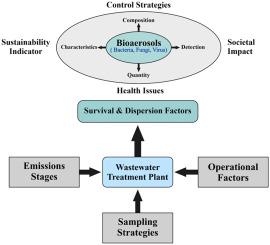Journal of Hazardous Materials ( IF 13.6 ) Pub Date : 2020-11-26 , DOI: 10.1016/j.jhazmat.2020.124686 Nitin Kumar Singh , Gaurav Sanghvi , Manish Yadav , Hirendrasinh Padhiyar , Arti Thanki

|
Wastewater treatment plants (WWTPs) associated bioaerosols have emerged as one of the critical sustainability indicators, ensuring health and well-being of societies and cities. In this context, this review summarizes the various wastewater treatment technologies which have been studied with a focus of bioaerosols emissions, potential emission stages, available sampling strategies, survival and dispersion factors, dominant microbial species in bioaerosols, and possible control approaches. Literature review revealed that most of the studies were devoted to sampling, enumerating and identifying cultivable microbial species of bioaerosols, as well as measuring their concentrations. However, the role of treatment technologies and their operational factors are investigated in limited studies only. Moreover, few studies have been reported to investigate the presence and concentrations of air borne virus and fungi in WWTP, as compared to bacterial species. The common environmental factors, affecting the survival and dispersion of bioaerosols, are observed as relative humidity, temperature, wind speed, and solar illumination. Further, research studies on recent episodes of COVID-19 (SARS-CoV-2 virus) pandemic also revealed that continuous and effective surveillance on WWTPs associated bioaerosols may led to early sign for future pandemics. The evaluation of reported data is bit complicated, due the variation in sampling approaches, ambient conditions, and site activities of each study. Therefore, such studies need a standardized methodology and improved guidance to help informed future policies, contextual research, and support a robust health-based risk assessment process. Based on this review, an integrated sampling and analysis framework is suggested for future WWTPs to ensure their sustainability at social and/or health associated aspects.
中文翻译:

关于污水处理厂相关生物气溶胶的最新研究:微生物多样性,潜在排放阶段,扩散因子和控制策略
废水处理厂(WWTPs)相关的生物气溶胶已成为关键的可持续性指标之一,可确保社会和城市的健康与福祉。在此背景下,本综述总结了已研究的各种废水处理技术,重点是生物气溶胶的排放,潜在的排放阶段,可用的采样策略,存活率和分散因子,生物气溶胶中的主要微生物种类以及可能的控制方法。文献综述显示,大多数研究致力于采样,枚举和鉴定可培养的生物气溶胶微生物种类,以及测量其浓度。但是,仅在有限的研究中研究了处理技术的作用及其操作因素。此外,与细菌种类相比,很少有研究报道污水处理厂中空气传播的病毒和真菌的存在和浓度。影响相对湿度,温度,风速和太阳光照的是影响生物气溶胶生存和分散的常见环境因素。此外,对最近发生的COVID-19(SARS-CoV-2病毒)大流行的研究也表明,对与污水处理厂相关的生物气溶胶进行持续有效的监视可能会导致未来大流行的早期迹象。由于每个研究的采样方法,环境条件和现场活动的差异,对报告数据的评估有些复杂。因此,此类研究需要标准化的方法和完善的指南,以帮助制定明智的未来政策,进行相关研究 并支持健全的基于健康的风险评估流程。在此审查的基础上,建议为未来的污水处理厂提供一个综合的抽样和分析框架,以确保其在社会和/或健康相关方面的可持续性。


























 京公网安备 11010802027423号
京公网安备 11010802027423号